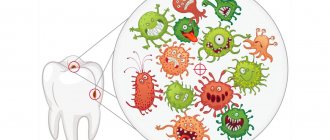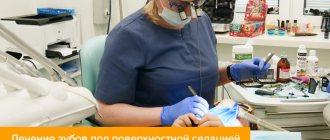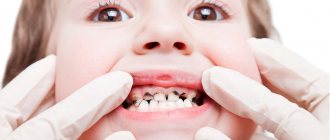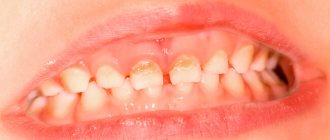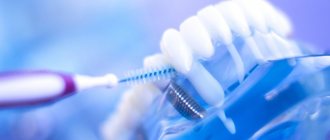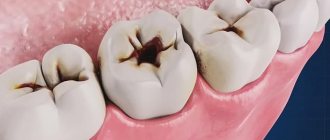Treatment of caries of children's primary teeth
Caries of primary chewing and front teeth has long been treated without the slightest pain.
New modern techniques have reduced the use of drills and drilling to a minimum, and timely scheduled examinations make it possible to detect the disease at a very early stage. The doctors at Aza&Buka Pediatric Dentistry who work with young patients are distinguished by an amazing sense of tact and constant positivity. Knowledge of the child’s psychology allows doctors to build communication and dialogue in such a way that children sit in the dental chair without the slightest fear. If the child already has some dental phobia, then adaptation techniques can solve the problem.
Caries on baby teeth in children is treated using the following technologies:
Possible complications
Some parents are in no hurry to visit a pediatric dentist because they consider it useless to treat baby teeth. This approach is explained by the fact that permanent ones will grow instead of them anyway.
Although the carious process itself does not transfer from baby teeth to permanent ones, untreated caries lesions have a detrimental effect on the condition of the latter. If you ignore superficial caries in children , complications may very soon manifest themselves:
- caries progresses rapidly in the absence of adequate therapy. This leads to the development of periodontitis and damage to the molar tooth germ. The inflammatory process significantly slows down the eruption of permanent teeth and complicates their growth;
- premature loss of baby teeth leads to the formation of malocclusion and disrupts the structure of the maxillofacial system;
- If at least one tooth is missing in the dentition, this complicates the process of chewing food. As a result, problems arise with the functioning of the digestive system.
Remember! Even the smallest stain can lead to complete tooth decay. There is no need to risk your child's health. It is much easier to visit the dentist and, if necessary, treat caries.
Classic filling
requires a special approach when treating young patients, since the doctor has to use dental equipment, which often causes fear in children.
Aza&Buka dentistry uses both traditional and modern methods of treating caries of primary teeth, selecting a method taking into account the age of the child and the degree of neglect of the process.
Plaksina Margarita
“Modern parents are great! They themselves are not afraid of dentists, and children are taught the same thing: to come on time for preventive appointments and examinations. In such cases, doctors can intercept the very beginning of a cavity infection and prevent tooth decay without drilling.”
Symptoms
The initial stage of caries does not have pronounced symptoms, but dentists still determine the presence of pathology based on some signs:
- enamel hypersensitivity to sweet, sour, hot and cold;
- at the moment of chewing food, the patient feels a sharp pain, which can be relieved by regular rinsing with warm water;
- the occurrence of aching pain during mechanical action;
- the affected area becomes yellow or gray.
When pressed during an instrumental examination, the dentist sees the heterogeneity of the enamel structure and its readiness to decay.
Milk caries: initial, superficial, medium, deep
Doctors distinguish 4 stages of the formation of carious areas:
- Initial caries - tooth enamel becomes covered with small spots of white or yellowish tint.
- Superficial caries - the enamel begins to deteriorate, small and light cavities are observed.
- Medium – the layer of tooth enamel is destroyed, the affected area extends deeper.
- Deep - the layers of dentin have already been affected, and the pulp is under threat.
It is necessary to treat milk caries at the very first stage, although it does not cause any discomfort in the child. The fact is that the enamel and crowns of temporary teeth are subject to rapid destruction, and the development of caries occurs very quickly. Deep caries often provokes irreversible changes, which leads to premature removal of the baby tooth.
Rodikova Tatyana
“Medium and deep caries most often occurs in schoolchildren, almost teenagers. Children brush their teeth poorly, and they talk about problems only when caries has already affected the pulp. In this case, the treatment turns out to be more unpleasant, since removal of the pulp cannot be avoided. That’s why I always ask parents to carefully monitor their teenagers’ hygiene and bring them to appointments on time.”
How is superficial caries treated in children?
The disease does not belong to the first stage of development; superficial destruction is characterized by softening of the hard tissues of the unit. The rotting process is occurring and needs to be stopped as quickly as possible. As long as only the enamel is affected by the disease, the tooth can be treated without pain or discomfort.
Stages of treatment:
- Cleansing soft plaque. Abrasive paste and brushes are suitable for this;
- Preparation in the affected area. At the superficial stage, the doctor can drill out defective areas and smooth out the contours;
- Isolation of the unit from salivary fluid. This is necessary so that saliva does not get on the filling, otherwise it will quickly fall out;
- Tooth enamel is etched with acid so that the filling material adheres to the tissue. The acid needs to be washed off;
- Coating with adhesive composition. It is an adhesive that ensures tight adhesion of the filling;
- Filling with composites and from them the dentist models the lost part of the tooth;
- Surface grinding and polishing.
Reasons for the development of caries in temporary teeth
When visiting a dentist, parents are invariably interested in the reasons for the appearance of such an unpleasant disease. This is important because it helps prevent damage to new teeth. Sometimes it is enough to change eating habits and hygiene patterns so that the child forgets about fillings for a long time, and only comes to the dentist for examinations.
Causes of caries:
- Poor or insufficient oral hygiene. Food remains in the interdental space and on the enamel are an excellent environment for the development of carious bacteria.
- An unbalanced diet with a preponderance of sweets and carbohydrates - during the fermentation of simple carbohydrates, acids are formed that provoke the destruction of enamel.
- The lack of solid foods in the menu leads to a decrease in the frequency of chewing, reduces salivation and becomes a common cause of caries of primary teeth in young children.
- Long-term use of nipples, including on bottles and sippy cups, increases the risk of developing single or multiple bottle caries of the anterior milk teeth in children.
- Rickets is a pathology that provokes the destruction of dental tissues.
- Genetic predisposition of the child.
- Problems with bite – various anomalies in the formation of the dentition.
- Decreased natural immunity due to frequent acute respiratory viral infections, chronic diseases, and taking various medications.
- Damage to tooth germs in the prenatal period - due to maternal illness or neglect of health in the first trimester.
Treatment and prevention
Due to minor damage to the enamel structure, both mineralization and tissue preparation are allowed for the treatment of superficial caries. The choice of technique depends on the current condition of the tooth, determined by two criteria:
- Roughness degree. If the outer layer has undergone minor changes, grinding, carried out mechanically or by air-abrasive methods, can eliminate the problem. The area from which the affected tissue was removed is restored using special compounds saturated with fluorine and minerals;
- Cavity depth. The appearance of a carious cavity, caused by internal tissue destruction, requires the removal of dead elements and the subsequent installation of a composite filling that covers the base of the tooth from external influences. Modern materials are durable and visually similar to the structure of natural enamel, which facilitates aesthetic restoration and guarantees restoration of the functionality of the dentition.
In the event that superficial caries has turned into a dark spot that worsens the appearance of the enamel, correction and treatment is carried out using dental methods. The dentist’s task is not only to eliminate the problem, but also to prevent recurrences of the pathology. The determination of the treatment plan is based on an analysis of the clinical picture, which allows us to establish the causes of the development of the disease.
Prevention of caries involves compliance with medical prescriptions, which does not require special efforts or additional costs associated with the purchase of special products. Regular hygienic oral care, giving up bad habits and periodically undergoing routine clinical examinations will prevent the development of pathology, and in case of remission, will help to identify and stop it in the initial stages.
Clinical manifestations of caries
The symptoms of the disease depend on what stage of development it is at.
Stage of carious stain:
- Clouding of tooth enamel, but maintaining its smoothness;
- The structure of the hard tissues of the tooth has not yet changed;
- The appearance of a white chalky spot (sometimes it disappears on its own).
Stage of superficial caries:
- The appearance of a dark dirty gray spot on the enamel;
- Its softening, which is detected during examination;
- Regular feeling of being on edge when consuming sweets.
Stage of middle caries:
- Tooth reaction to chemical and temperature stimuli;
- Moderate short-term pain;
- The appearance of a cavity in which food fragments accumulate.
Stage of deep caries:
- Sharp but short-term pain symptoms when exposed to temperature and chemical stimuli;
- It also occurs during chewing or due to accidental pressure or other impacts on the carious cavity;
- When food fragments remain in the cavity, long-term, aching pain occurs;
- Unpleasant odor from the mouth.
It is worth noting that with deep chronic caries, a carious cavity can form over several years. The patient will not experience pain - they will appear only when the dentin is completely destroyed. As for the acute form, the pain symptoms are much more pronounced.
Diagnostic methods
In most cases, the dentist discovers superficial caries during a routine examination. Sometimes patients independently complain of sharp pain when brushing their teeth or eating hot food. Basic diagnostic methods:
- Visual inspection. Using a mirror, the specialist carefully examines the structure of each tooth, interdental spaces, and interviews the patient. It is important to detect chalk spots at the initial stage, to assume the development of cervical or atypical caries.
- Percussion. An effective diagnostic method is tapping the affected tooth. Based on the nature of the sound, the specialist suggests the development of an inflammatory process. When pressing on a complication of caries, the appearance of pain and discomfort is indicated.
- Probing. During the examination, the doctor uses a special probe, which makes it possible to accurately determine the degree of development of caries and the location of white spots.
- Carrying out a thermal test. The patient is offered cold water or cotton balls soaked in a special solution. With caries, the tooth may respond with pain in response to an irritant.
Some dentists additionally use vital staining to identify areas affected by caries. Methylene blue dye is applied to the dried and cleaned tooth. Carious spots stand out on the treated surface.
Among modern diagnostic methods:
- Luminescence. When illuminated, ultraviolet light passes through the tooth tissue. Areas affected by caries are distinguished by dark spots on a light background.
- Transluminescence. Conducted in a darkened office. After applying a special dye, when illuminated, spots devoid of calcium stand out as dark shadows on the tooth.
An effective and accessible method for diagnosing atypical forms of caries is radiography. In the photographs, the dentist can detect structural changes in the roots, the formation of a carious cavity near the canals or root.
Pathogenesis of the disease
There are several main theories as to why tooth decay develops. But the multifactorial approach is generally accepted among dentists, according to which the cause of tooth decay is exposure to harmful microorganisms. As a result of their vital activity, the level of organic acids in the oral cavity increases. Acidic compounds corrode the surface of tooth enamel, reducing the level of dentin protection.
The disease develops under the influence of 4 main factors:
- condition of teeth and general well-being of a person, the presence of chronic diseases of the endocrine system, pathologies of bone tissue;
- poor nutrition, excess of light carbohydrates, lack of vitamins and microelements;
- violation of hygiene rules, which leads to the growth of pathogenic microflora in the mouth;
- the time factor is the reluctance to promptly treat caries, eliminate demineralization, and carry out preventive teeth cleaning.
When all the negative factors come together, the process of plaque formation begins. Main stages:
- Pellicle. On the surface of the enamel, an invisible microfilm is formed from bacterial plaque and waste products of microorganisms.
- Active growth of colonies of pathogenic bacteria. Their level increases sharply within 2-3 days after the formation of the pellicle.
- Formation of mature dental plaque. This is the area on the surface of the tooth that is most susceptible to caries.
The rate of development of the disease directly depends on the frequency of tooth brushing, the nature of food, the quality of hygiene and oral care.
